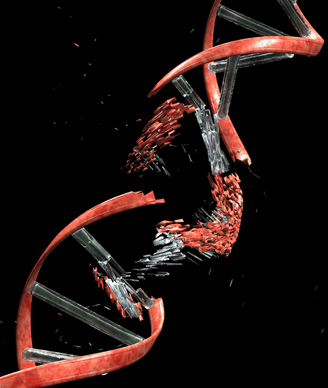BRCA-Associated Cancer Risk May Vary by Mutation Type
Researchers have used observational study data to better define risks for breast and ovarian cancers associated with mutations in the BRCA1 or BRCA2 genes.
Image © Constantin-Ciprian/Shutterstock.com

Researchers have used observational study data to better define risks for breast and ovarian cancers associated with mutations in the BRCA1 or BRCA2 genes in an attempt to improve risk assessment and cancer prevention among women who carry these mutations.
“This study is the first step in defining differences in risk associated with location and type of BRCA1 and BRCA2 mutations,” wrote Timothy R. Rebbeck, PhD, of the Perelman School of Medicine at the University of Pennsylvania, Philadelphia, and colleagues in JAMA. “Pending additional mechanistic insights into the observed associations, knowledge of mutation-specific risks could provide important information for clinical risk assessment among BRCA1/2 mutation carriers, but further systematic studies will be required to determine the absolute cancer risks associated with different mutations.”
Rebbeck and colleagues conducted an observational study of women found to have BRCA1 (n = 19,851) or BRCA2 (n = 11,900) mutations between 1937 and 2011. Data were collected from 55 centers in 33 countries.
They found that among BRCA1 mutation carriers, 46% were diagnosed with breast cancer, 12% with ovarian cancer, and 5% with both cancers. Only 37% of BRCA1 carriers were without cancer diagnosis.
Looking at women who were BRCA2 mutation carriers, the data showed that 52% of women were diagnosed with breast cancer, 6% with ovarian cancer, and 2% with both. Forty percent of women were without cancer diagnosis.
The researchers also sought to better define these mutations by identifying their locations and estimated the RHR, or the ratio of breast compared with ovarian cancer hazard ratios. For BRCA1 carriers, they identified three breast cancer cluster regions (BCCRs) at c.179 to c.505 (BCCR1; RHR = 1.46; 95% CI, 1.22-1.74; P = 2 × 10−6), c.4328 to c.4945 (BCCR2; RHR = 1.34; 95% CI, 1.01-1.78; P = .04), and c.5261 to c.5563 (BCCR2′, RHR = 1.38; 95% CI, 1.22-1.55; P = 6 × 10−9), and one ovarian cancer cluster region (OCCR) at c.1380 to c.4062 (approximately exon 11) with RHR = 0.62 (95% CI, 0.56-0.70; P = 9 × 10−17), “suggesting a relative decrease in breast relative to ovarian cancer risk,” the researchers wrote.
BRCA2 mutations had breast cancer cluster regions at c.1 to c.596 (BCCR1; RHR = 1.71; 95% CI, 1.06-2.78; P = .03), c.772 to c.1806 (BCCR1′; RHR = 1.63; 95% CI, 1.10-2.40; P = .01), and c.7394 to c.8904 (BCCR2; RHR = 2.31; 95% CI, 1.69-3.16; P = .00002), and OCCRs spanning c.3249 to c.5681 that was adjacent to c.5946delT (6174delT; RHR = 0.51; 95% CI, 0.44-0.60; P = 6 × 10−17) and c.6645 to c.7471 (OCCR2; RHR = 0.57; 95% CI, 0.41-0.80; P = .001).
“To illustrate potential mutation-specific effects on absolute cancer risks, we used the hazard ratio estimates to derive approximate absolute risks and 95% confidence intervals, based on published estimates for the overall risks of breast and ovarian cancer by age 70 years,” the researchers explained. “These estimates are for illustration and do not represent absolute risk estimates that would be required in a genetic counseling setting as they do not account for noncancer outcomes that may influence a woman’s life expectancy, the effects of family history, and nonrandom ascertainment of mutation carriers in this sample and depend on assumptions about the prevalence of different mutation classes in the population.”
They estimated that BRCA1 mutations carriers had an overall breast cancer risk of 59% by age 70, which increases to a risk of 69% if the woman carries a missense mutation, Jewish founder mutation, or a mutation that undergoes nonsense-mediated decay with reinitiation. BRCA1 mutation carriers had a 34% risk for ovarian cancer by age 70, but this risk decreases among women with a founder mutation.
“It is yet to be determined what level of absolute risk change will influence decision-making among carriers of BRCA1/2 mutations,” the researchers wrote. “Additional research will be required to better understand what level of risk difference will change decision-making and standards of care, such as preventive surgery, for carriers of BRCA1 and BRCA2 mutations.”
Newsletter
Stay up to date on recent advances in the multidisciplinary approach to cancer.